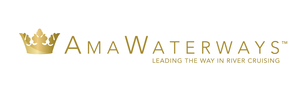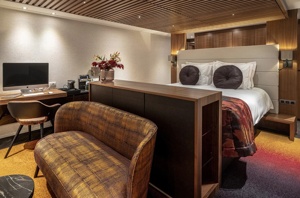As imagined by AmaWaterways' Co-Founder, Co-Owner and President Rudi Schreiner, the “Godfather of River Cruising,” the one-of-a-kind AmaMagna is the flagship of our award-winning river fleet. Twice the width of traditional European river ships and offering the luxury of space, four unique dining venues and more leisure opportunities, the innovative AmaMagna has redefined the river cruise experience! Most accommodations are spacious suites measuring 355 to 710 sq. ft. with full balconies. In addition to the Main Restaurant and The Chef's Table, AmaMagna offers Jimmy's, a family-style restaurant named for AmaWaterways' late Co-Owner Jimmy Murphy, and the intimate Al Fresco Restaurant, serving up delicious vegetable-forward fare. Both a sun-deck pool and whirlpool invite guests to refresh and enjoy the views, while AmaMagna's Zen Wellness Studio is an expansive space with a fitness centre, two massage rooms and a refreshing juice bar. A brand-new full-size pickleball court will also be featured on the Sun Deck, debuting in 2023. With connecting staterooms and triple/quadruple accommodations available, AmaMagna is also the perfect river cruise ship for families and groups!
Honoured as one of TIME Magazine's “World's Greatest Places” in its first year, our extraordinary AmaMagna has been reimagining river cruising on the Danube since its debut. With several “Best River Cruise Ship” distinctions, Forbes' 2024 “Best European River Cruise for Active Travelers” and awards for its luxury suites and pickleball court, our innovative flagship designed by the “Godfather of River Cruising” continues to exceed expectations.
Cruise ID: 53359
With a complimentary fleet of bicycles—and helmets—on board, guests have the opportunity to explore on guided bike tours, or discover a new path all on their own. Guided hiking tours also offer active ways to see grand cities and villages from a different perspective.
EUROPE
7-Night Cruise - Ship's Crew: The entire amount will be divided equally amongst all crew members. Recommendation: 100 Euros per 7-night cruise, per guest. (AmaMagna 120 Euros per 7-night cruise, per guest)
7-Night Cruise - Cruise Manager: Your Cruise Manager is not part of the ship's crew and is the AmaWaterways representative who also accompanies you on any pre- and/or post-cruise hotel/land extensions you may have booked. Recommendation: 25 Euros per 7-night, per guest; 4 Euros for each additional day, per guest for pre- and post-cruise hotel/land extensions.
10-Night Cruise - Ship's Crew: The entire amount will be divided equally amongst all crew members. Recommendation: 143 Euros per 10-night cruise, per guest.
10-Night Cruise - Cruise Manager: Your Cruise Manager is not part of the ship's crew and is the AmaWaterways representative who also accompanies you on any pre- and/or post-cruise hotel/land extensions you may have booked. Recommendation: 36 Euros per 10-night, per guest; 4 Euros for each additional day, per guest for pre- and post-cruise hotel/land extensions.
11-Night Cruise - Ship's Crew: The entire amount will be divided equally amongst all crew members. Recommendation: 158 Euros per 11-night cruise, per guest.
11-Night Cruise - Cruise Manager: Your Cruise Manager is not part of the ship's crew and is the AmaWaterways representative who also accompanies you on any pre- and/or post-cruise hotel/land extensions you may have booked. Recommendation: 40 Euros per 11-night, per guest; 4 Euros for each additional day, per guest for pre- and post-cruise hotel/land extensions.
14-Night Cruise - Ship's Crew: The entire amount will be divided equally amongst all crew members. Recommendation: 200 Euros per 14-night cruise, per guest.
14-Night Cruise - Cruise Manager: Your Cruise Manager is not part of the ship's crew and is the AmaWaterways representative who also accompanies you on any pre- and/or post-cruise hotel/land extensions you may have booked. Recommendation: 50 Euros per 14-night, per guest; 4 Euros for each additional day, per guest for pre- and post-cruise hotel/land extensions.
















